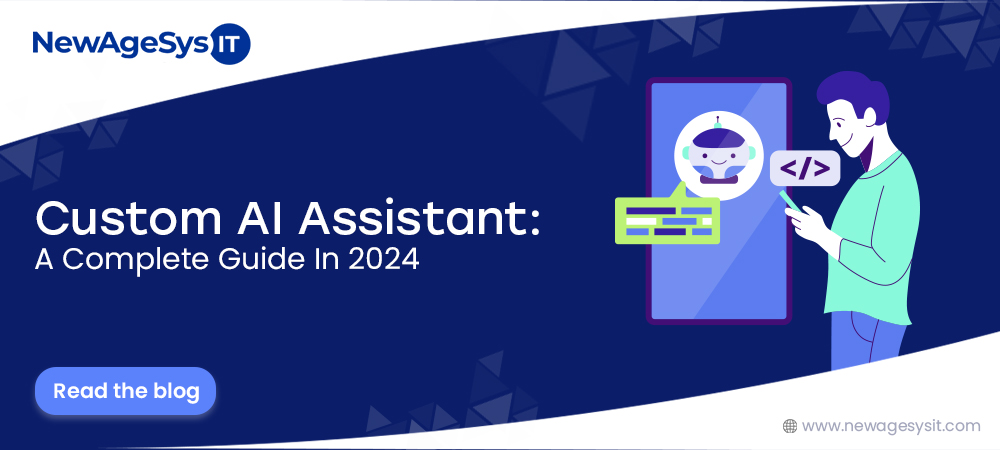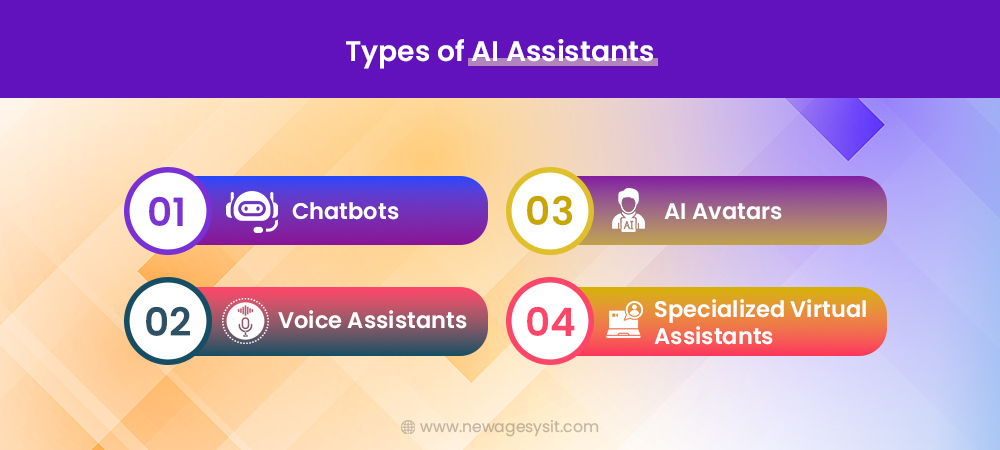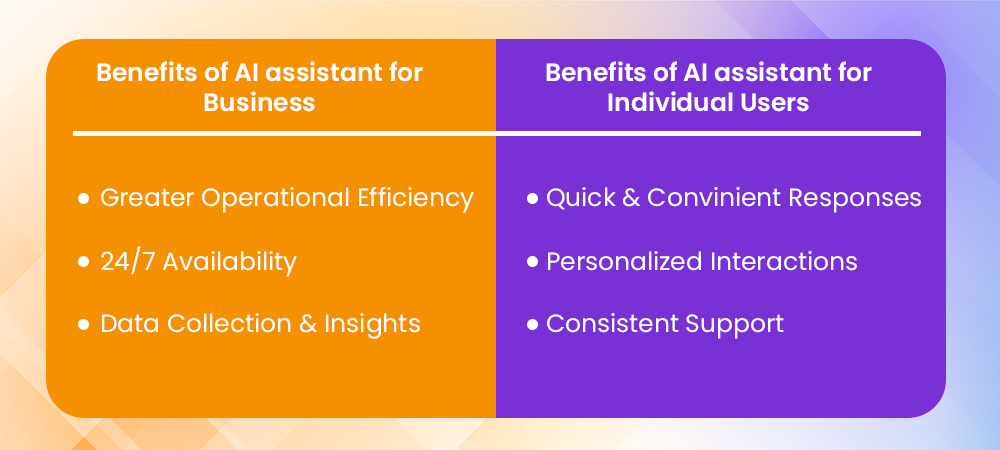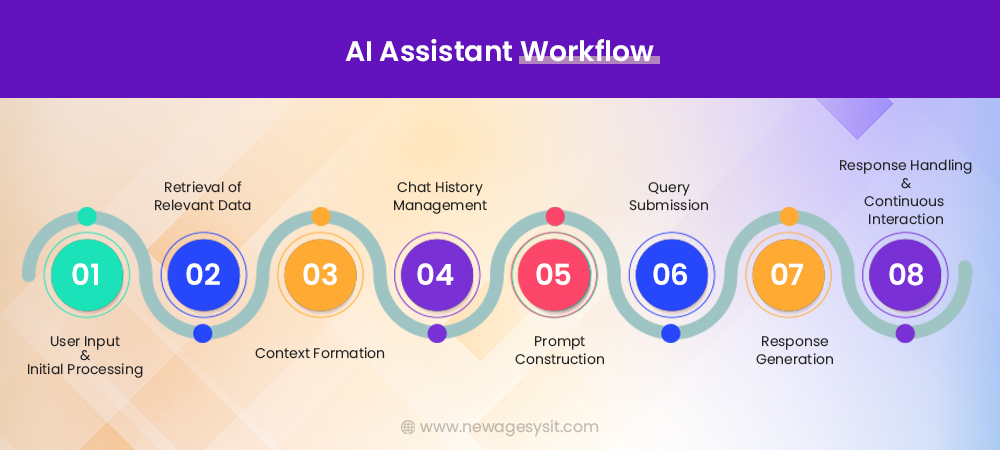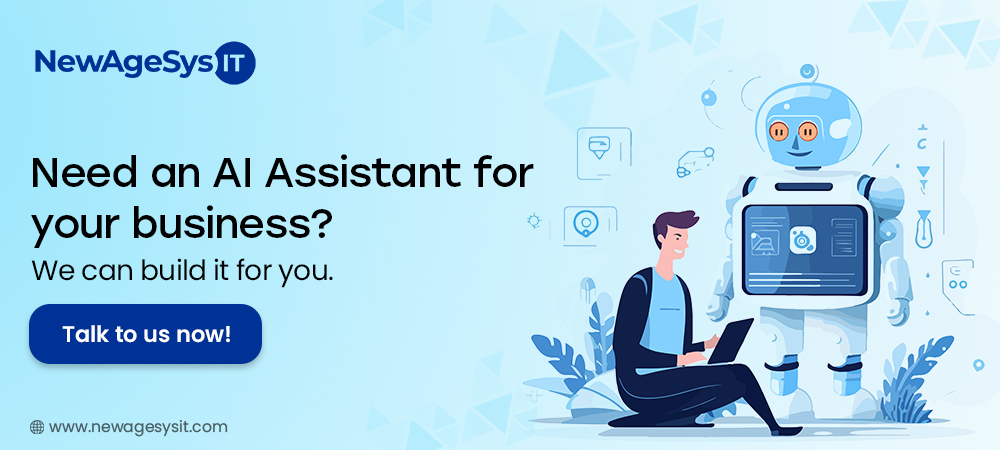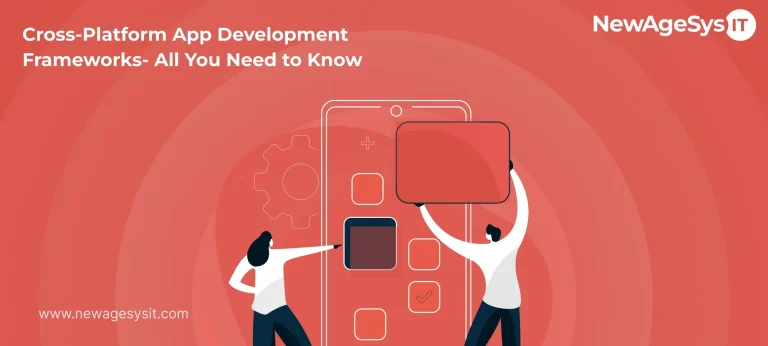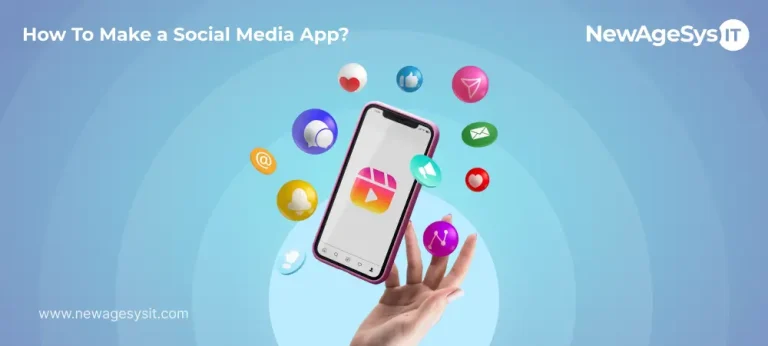The corporate landscape is being completely transformed by artificial intelligence, which offers an abundance of chances for development and innovation. Artificial intelligence (AI) assistants are among these innovations; they are powerful tools that can boost output. At NewAgeSysIT, we created our AI-powered assistant to stay ahead of the curve. We’ll talk about our experience developing AI solutions today, with an emphasis on our AI assistance. We’ll go over its main idea, and the advantages it provides, and give you a better grasp of how it works.
Understanding AI Assistants
Let’s start with the basics before getting into the finer points of creating an AI Assistant. Artificial intelligence (AI) assistants, such as chatbots and virtual assistants, are software programs created to carry out diverse functions and reply to human requests. These might be as basic as sending out weather alerts and setting alarms, or they can be as sophisticated as machine learning and natural language processing.
Google Translate is a great illustration of this technology and shows how well it can overcome language boundaries. With more than 1 billion installations globally, it demonstrates the important influence of these kinds of apps. One of the top companies for custom software development, NewAgeSysIT specializes in building AI assistants that are customized to your exact specifications. View our portfolio right now!
Types of AI Assistants
Based on their main purposes, artificial intelligence assistants can be divided into multiple broad categories:
Chatbots
- Using chat interfaces, these AI-powered computers communicate with users. They are frequently employed in customer service to help with different procedures and answer standard questions. Your customer service experience can be revolutionized by an AI chatbot that offers round-the-clock assistance and automatic responses.
Voice Assistants
- With voice assistants like Siri, Alexa, and Google Assistant, commands like “Alexa, turn on the TV” have become normal. These assistants can do a wide range of jobs, including playing music, delivering weather reports, creating reminders, and controlling smart home appliances. They are largely controlled by voice requests.
AI avatars
- Artificial intelligence avatars are animated or graphical depictions of AI assistance. They are frequently used to create interactive and visually appealing experiences for users on websites and applications. Numerous industries, including gaming, customer service, and virtual worlds, use these avatars. These avatars find their application in various fields, such as gaming, customer support, or virtual environments.
Specialized Virtual Assistants
- Specialized virtual assistants help with particular jobs or industries. For example, a virtual assistant in the banking industry can help manage investment portfolios, while one in the healthcare industry can help with medical diagnosis. These assistants are tailored to provide expertise and knowledge in particular fields.
Different kinds of AI assistants are made to fit several scenarios, purposes, and user interactions, and they are for certain tasks. If you wish to build any of the above, experts at NewAgeSysIT can help you with custom software development.
Key Benefits of Developing Your AI Assistant
Creating your own AI assistant offers a multitude of advantages. Here are some compelling reasons to consider embarking on this journey:
Custom Solutions
Off-the-shelf AI assistants may not provide all the features you need. By developing a custom assistant, you can tailor its functionalities to suit your specific requirements, whether for research support, smart home management, or task automation. As a premier provider of custom software development, NewAgeSysIT can craft AI assistants uniquely designed for you.
Personalization
Developing your AI assistant allows for significant personalization. Unlike generic solutions, your assistant can adapt to your individual preferences and tasks, learning about your routines to deliver a tailored experience that boosts productivity and quality of life.
Learning Opportunities
Creating your own AI assistant is a fantastic way to delve into the realms of artificial intelligence, machine learning, and natural language processing. This experience will enhance your understanding of these technologies and how to leverage them for effective solutions.
Autonomy
Relying on third-party AI assistants means adhering to their limitations. In contrast, developing your assistant grants you the freedom to define its functionalities and interactions according to your preferences.
A recent PwC survey revealed that 73% of organizations view customization and independence as crucial factors in deciding whether to develop their AI solutions.
Data Security
By building your AI assistant, you maintain control over your data. Unlike some commercial AI solutions that may collect and monetize personal information, your custom assistant can prioritize data privacy and security, offering you peace of mind.
Enhanced Efficiency
According to a McKinsey report, AI-driven automation can boost productivity by up to 20%. By creating your AI assistant, you can streamline tasks like generating reminders, automating repetitive activities, and managing your schedule, allowing you to focus on more significant endeavors.
Scalability
You have the flexibility to expand and enhance your AI assistant as your needs evolve. You can augment its capabilities, introduce new features, and integrate it seamlessly with other devices and services. Being in control of its development opens up endless customization possibilities.
Innovation
Making your AI-powered assistant allows you to unleash the full potential of innovation and creativity. It provides access to state-of-the-art technology like voice recognition and chatbots for you and your team, creating new possibilities for personal and professional growth.
Integration
It’s simple to combine different apps and services when your AI assistant acts as a central hub. Your digital life is streamlined by this convenient integration, which provides a single point of contact for many tasks including email management and smart device control.
In conclusion, there are a lot of advantages to building your own AI assistant. This journey blends creativity and technology, giving you total control over a digital assistant that has the potential to completely transform your daily routine at work and in your personal life. All things considered, AI assistants can be a useful asset in your digital toolbox. It is better to consider a leading custom application development company that specializes in custom software development services to build your AI Assistant.
The complete process outlined
So now you have got an idea of the benefits AI assistants offer to you. Let’s now zoom into how the entire chain of commands works.
User input and initial processing
So, the first process is where the user enters a query to the application or system. This input data then gets converted into vector embeddings, representing the semantic meaning of the user’s request.
Obtaining pertinent information
Subsequently, the retriever employs vector embeddings in a semantic search to identify pertinent data that aligns with the user’s query. It then takes the most pertinent data out of the vector database. Articles from companies, case studies, and service pages that weren’t included in the first LLM training are frequently included in this data.
Context formation
The retrieved data forms the context that the model will use for further analysis. In order to produce precise and pertinent answers, this context is essential.
Chat history management
When considering our thing, we store the chat history in Redis memory (used for data storage). What it does is that it helps to keep the continuity of the conversation by remembering previous interactions. So when the next interaction begins, the system extracts the chat history from Redis to provide context for the ongoing conversation.
Prompt construction
Prompting is the next stage. The system sets together various factors to build a prompt. This basically covers instructions and rules for the model, user information, chat history, and any additional retrieved context. Undoubtedly, this prompt serves as the basis for building a query for the model.
Query submission
The developed query is now shared with the OpenAI API.
Response generation
What happens next is that the OpenAI model processes the query, and based on the context and the prompt given it generates a response or an answer.
Response handling and continuous interaction
Now, this is an answer stage. After getting the answer, the generated answer will be immediately delivered to the user. An output parser can be used as an alternative to receive the response. The response is then sent to the user by the parser after being formatted into the necessary format (such as JSON or CSV).
The AI assistant keeps interacting with the user, using Redis memory to preserve context and modifying its responses in reaction to new information. This procedure guarantees that the AI assistant can effectively handle customer inquiries, obtain pertinent data, and produce contextually appropriate answers—all while preserving a consistent and cohesive interaction.
If you wish to build an AI Assistant, custom software development companies like ours can help you with the best. You can hear straight from our clients how our custom software development services helped them build custom AI Assistants.
10 Steps to Create an AI Assistant
- Define the purpose of your AI assistant to guide the development process.
- Select a technology stack based on the required functionalities and your technical expertise.
- Gather datasets to train your AI assistant in understanding and generating human language.
- Clean and preprocess the data by tokenizing and removing irrelevant words.
- Train the AI model using your data and optimize it for the desired tasks.
- Design an intuitive user interface for seamless user interaction.
- Optionally, implement voice recognition for voice-based commands.
- Test and debug the AI assistant to ensure it responds as expected.
- Deploy the AI assistant on your chosen platform for user interaction.
- Continuously improve the assistant based on user feedback and market trends.
Wrapping Up
Creating an AI assistant is a difficult but rewarding project. It gives you access to the fascinating world of artificial intelligence and gives you the ability to create a unique tool that makes your life easier or perhaps acts as the basis for a new business idea.
Our collection of case studies includes personalized AI assistants designed to meet your unique requirements. At NewAgeSysIT, one of the top custom software development companies, we take great pride in developing superior software products, simple solutions to comprehensive marketplaces, and thoughtful SaaS products.
So let’s get in contact if our approach and experience caught your attention! Keep in mind that constructing an AI assistant is challenging, and you may face hurdles during the process. However, using the insights in this guide will put you on the right path to developing your virtual assistant. Therefore, prepare yourself to begin your journey of building an AI assistant and witness the transformation as your creation springs to life.

